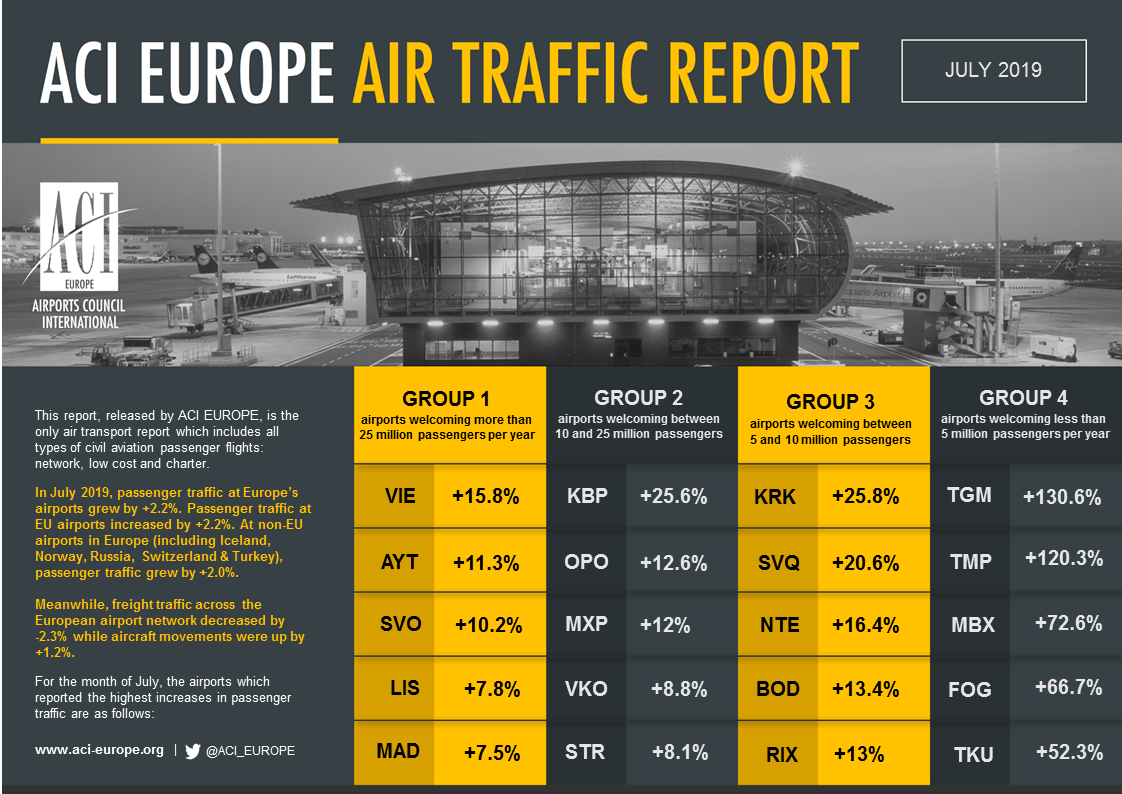July airport traffic results reveal significant slowdown in growth
16 September 2019Brussels - European airport trade association, ACI EUROPE today releases its traffic report for July 2019, during which average passenger traffic in geographical Europe expanded by +2.2% compared with the same month in 2018. Standing at less than half the growth of the preceding month (June: +4.7%), this is the weakest monthly performance so far this year.
Meanwhile, Freight traffic declined for the 9th month in a row at -2.3%. Growth in aircraft movement was subdued at +1.2% - compared to +3.8% at the start of the year.
Olivier Jankovec, Director General of ACI EUROPE commented “July marked a significant slowdown for Europe’s airports. Passenger traffic is no longer defying economic gravity and the performance gap with freight traffic is narrowing. Beyond economic and geopolitical factors, this reflects airlines being much more cautious about capacity growth & new route openings. ATM inefficiencies, fuel & labour costs, the grounding of the B737MAX and aircraft delivery delays are all adding to demand pressures. While these demand pressures are mainly driven by economic factors, the fact that the slowdown comes primarily from a fall in domestic passenger traffic (-1.5%) may be pointing to a nascent impact of changing attitudes towards air transport - as a result of the Climate Emergency.”
EU & NON EU MARKETS ALMOST ALIGNED
Airports in the EU market posted an average increase of +2.2% in passenger traffic in July – the weakest monthly performance in more than 5 years.
The Austrian and Latvian markets were the only ones achieving double digit growth (+14.1% and +13% respectively), while airports in Portugal (+7%), Finland (+6.5%), Hungary (+6.1%), Malta (+5.3%), Croatia (+5.1%), Romania and Slovenia (+4.4%) still significantly outperformed the EU average.
At the other end of the spectrum, several national markets registered passenger traffic declines - Bulgaria (-8.8%), Slovakia (-5.3%), Sweden (-3.8%), Lithuania (-3.2%), Denmark (-0.9%) and the Netherlands (-0.1%). Growth was also either flat or weak in Luxembourg (0%), the UK (0.1%), Greece (0.5%), and Germany (+1.3%).
Amongst capital & larger EU airports, the best results were achieved by Vienna (+15.8%), Riga (+13%), Milan-Malpensa (+12%), Lisbon (+7.8%), Madrid (+7.5%), London-Luton (+6.7%), Budapest (+6.1%) and Helsinki (+5.7%).
Passenger traffic expanded by +2% at non-EU airports in July, with the growth being dragged down by Iceland (-29% following the bankruptcy of WOW and severe airline capacity adjustments), Georgia (-7.4%), Turkey (-0.2%) and Norway (0%). However, airports in Ukraine, Bosnia-Herzegovina, Albania and Belarus achieved impressive gains – all posting double-digit growth.
Accordingly, amongst capital & larger non-EU airports, the best performances came from: Kyiv (+25.6%), Kharkhiv (+25.1%), Sarajevo (+13.5%), Tirana (+11.4%), Antalya (+11.3%), Minsk (+10.8%) and Moscow-Sheremetyevo (+10.2%).
MAJORS FLAT & SMALL REGIONALS HARDEST HIT
Passenger traffic at the Majors (top 5 European airports) was flat in July at +0.2%. Only Paris-CDG (+3.9%) and Frankfurt (+0.9%) were positive, while Amsterdam-Schiphol (-0.7%), London-Heathrow (-0.8%) and Istanbul-IST (-2.1%) saw passenger volumes declining.
Smaller regional airports (with less than 5 million passengers per annum) were the hardest hit by the slowdown, posting a decrease of -0.9% in passenger traffic. 53% of them lost passenger traffic in July, compared to an industry average of 44%.
Larger regional airports as well as those serving popular tourist destinations did better, with some of them still posting significant gains: Zadar (+27.2%), Krakow (+25.8%), Sevilla (+20.6%), Nantes (+16.4%), Brest (+13.7%), Bordeaux (+13.4%), Oporto (+12.6%), Bari & Brindisi (10.8%) and Naples (+10.6%).
FREIGHT DECLINED LED BY EU MARKET
Freight traffic at EU airports dropped by -3.1% in July, while non-EU airports still posted an increase of +1.4%. Amongst the top 10 European airports for freight traffic, the best performance was achieved by Madrid (+8.4%) and Frankfurt (+1.3%).
During the month of July, airports welcoming more than 25 million passengers per year (Group 1), airports welcoming between 10 and 25 million passengers (Group 2), airports welcoming between 5 and 10 million passengers (Group 3) and airports welcoming less than 5 million passengers per year (Group 4) reported an average adjustment +2.1%, +3.9%, +1.6% and -0.5%.
The airports that reported the highest increases in passenger traffic during July 2019 (compared with July 2018) are as follows:
GROUP 1: Vienna (+15.8%), Antalya (+11.3%), Moscow SVO (+10.2%), Lisbon (+7.8%) and Madrid (+7.5%)
GROUP 2: Kyiv-Boryspil (+25.6%), Porto (+12.6%), Milan MXP (+12%), Moscow VKO (+8.8%) and Stuttgart (+8.1%)
GROUP 3: Krakow (+25.8%), Seville (+20.6%), Nantes (+16.4%), Bordeaux (+13.4%) and Riga (+13%)
GROUP 4: Targu Mures (+130.6%), Tampere (+120.3%), Maribor (+72.6%), Foggia (+66.7%) and Turku (+52.3%)


